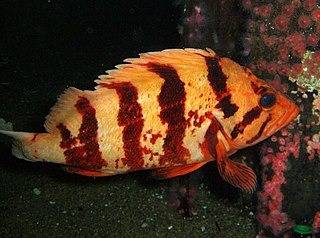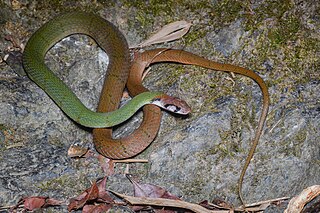
Coral snakes are a large group of elapid snakes that can be divided into two distinct groups, the Old World coral snakes and New World coral snakes. There are 27 species of Old World coral snakes, in three genera, and 83 recognized species of New World coral snakes, in two genera. Genetic studies have found that the most basal lineages have origins in Asia, suggesting that the group originated in the Old World. While new world species of both genera are venomous, their bites are seldom lethal; only two confirmed fatalities have been documented in the past 100 years from the genus Micrurus. Meanwhile, snakes of the genus Micruroides have never caused a medically significant bite.

Hydrophis nigrocinctus, or the black-banded sea snake, is a species of marine venomous snakes in the family Elapidae. There have only been three specimens discovered. The first was described in 1803, and was collected in the Bay of Bengal, Sundarbans, near Kolkata. The second specimen was caught in the Malay Archipelago, in 1896. Over a century later, the third specimen was rediscovered in February 2015, and described in 2024. This also marked a century since black-banded sea snakes had been sighted in Bangladesh. The third specimen was found in the Sundarbans of Bangladesh, namely, the island Dublar Char.

Rhabdophis is a genus of snakes in the subfamily Natricinae of the family Colubridae. Species in the genus Rhabdophis are generally called keelback snakes, and are found primarily in Southeast Asia.
Procambarus nigrocinctus, the blackbelted crayfish, is a species of crayfish in the family Cambaridae. It is listed as a species of Least Concern on the IUCN Red List, because it is known from more than 100 sites across thirteen counties in Texas, where it is endemic to the Neches River system, and is common and widespread in a national park.

Salarias is a genus of combtooth blennies found in the Indian and Pacific oceans.

Opharus is a genus of moths in the family Erebidae. The genus was erected by Francis Walker in 1855.

The tiger rockfish, also called tiger seaperch, banded rockfish and black-banded rockfish, is a species of marine ray-finned fish belonging to the subfamily Sebastinae, the rockfishes, part of the family Scorpaenidae. It is native to the waters of the Pacific Ocean off western North America.
Dublar Char is an island in Bangladesh with an area of 66.5 km2, located in the Bagerhat District of the Khulna Division. It's a tourist destination inside Sundarban. Only Teletalk Internet & Mobile Network is available here. Fisherman live here during fishing season for three to four months and have demanded a floating hospital from the Government of Bangladesh. The island hosts a Raas Mela (fair) annually.

Micrurus nigrocinctus, commonly known as the Central American coral snake, is a species of a highly venomous snake in the family Elapidae. The species is endemic to Latin America from southern Mexico, Central America, to north Colombia. There are six recognized subspecies, including the nominate subspecies described here.
Salarias nigrocinctus, the blackstreaked blenny, is a species of combtooth blenny found in the Pacific ocean, around Tonga.
Micrurus nigrocinctus babaspul, or the babaspul, is a subspecies of Micrurus nigrocinctus, commonly known as the Central American coral snake. M. n. babaspul is a venomous elapid from Big Corn Island, Nicaragua. According to O'Shea (2008) this is an endangered subspecies, and the subspecies may even be extinct.

Heterachthes is a genus of beetles in the family Cerambycidae, containing the following species:

Cyrtotrachelus is a genus of beetles belonging to the family Curculionidae.

Rhabdophis nigrocinctus, also known as the black-striped keelback, green keelback, or banded keelback, is a keelback snake in the family Colubridae found in Myanmar, Thailand, Laos, Cambodia, Vietnam, and Yunnan.
Opharus nigrocinctus is a moth of the family Erebidae. It was described by Walter Rothschild in 1935. It is found in the Brazilian states of Rio Grande do Sul and Santa Catarina.

Adesmus is a genus of longhorn beetles of the subfamily Lamiinae, containing the following species:
Cryptocephalus nigrocinctus is a species of case-bearing leaf beetle in the family Chrysomelidae. It is found in the Caribbean Sea and North America.
Cenaspis aenigma is a species of colubrid snake in the subfamily Dipsadinae and the only member of the monotypic genus Cenaspis. It is endemic to the highlands of western Chiapas, Mexico, where it was described from a single, partially digested male specimen found in the stomach of a Central American coral snake. This is referenced in its generic name, as cena is Spanish for "dinner". Despite being partially digested, the specimen still displayed many unique traits, including undivided subcaudals for the full length of the tail, as well as a simple hemipenis completely covered in calyces with a largely non-bifurcated sulcus spermaticus. These traits are not known from any other colubroid snake in the Western Hemisphere.
Chthonothrips is a genus of thrips in the family Phlaeothripidae.
Gluviopsis is a genus of daesiid camel spiders, first described by Karl Kraepelin in 1899.










